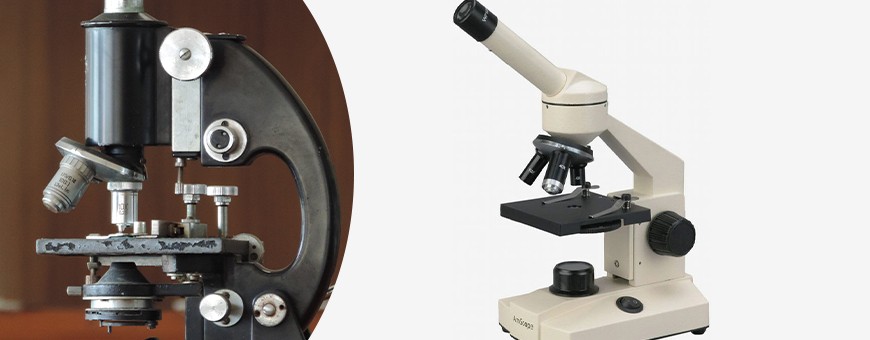Same Day Shipping EMI & COD on most products
Trusted Partner Since 1969
GST B2B Billing  Help
Help  00919699976817
00919699976817

Microscopes: A Deep Dive into the Minuscule World
Microscopes have revolutionized the way we perceive the world. From the tiniest organisms to the intricate details of inanimate objects, microscopes have unveiled a universe that was once invisible to the naked eye. This article delves into the fascinating world of microscopes, their evolution, and their indispensable role in various fields.
The Evolution of Microscopes
The journey of microscopes began in the late 16th century when the first compound microscope was invented. This rudimentary device consisted of multiple lenses that magnified objects, allowing scientists to observe details that were previously unseen. Over the centuries, the design and functionality of microscopes have undergone significant transformations.
In the 20th century, the advent of electron microscopes marked a groundbreaking moment in the field of microscopy. Unlike traditional optical microscopes that use light, electron microscopes employ a beam of electrons to magnify objects. This innovation has enabled scientists to achieve magnifications of up to 50 million times, revealing atomic structures.
Types of Microscopes and Their Applications
Microscopes can be broadly categorized into two types: optical and electron microscopes.
Optical Microscopes: These are the most common type of microscopes and use light to magnify objects. They are widely used in schools, colleges, and research institutions. Variants of optical microscopes include compound, stereo, and phase-contrast microscopes.
Electron Microscopes: These offer higher magnification and resolution than optical microscopes. There are two main types of electron microscopes: Transmission Electron Microscopes (TEM) and Scanning Electron Microscopes (SEM). TEM provides detailed views of the internal structure of specimens, while SEM offers three-dimensional images of surfaces.
Microscopes play a pivotal role in various fields:
Biology: To study cells, tissues, and microorganisms.
Medicine: For diagnosing diseases and researching medical conditions.
Material Science: To analyze the properties of different materials.
Forensics: In crime scene investigations to examine evidence.
Geology: To study minerals and the structure of rocks.
The Future of Microscopy
With advancements in technology, the future of microscopy looks promising. The development of super-resolution microscopes has shattered the perceived limits of optical microscopy. These microscopes can visualize structures smaller than the wavelength of light, offering unprecedented clarity.
Furthermore, the integration of artificial intelligence and machine learning with microscopy is opening new avenues. Automated microscopes equipped with AI can analyze samples at a rapid pace, making diagnoses and research more efficient.
Conclusion
Microscopes have not only expanded our understanding of the world but have also paved the way for numerous scientific breakthroughs. As technology continues to evolve, microscopes will undoubtedly play an even more crucial role in shaping the future of science and medicine.
The introduction of electron microscopes in the 20th century marked a significant advancement in microscopy. Unlike traditional optical microscopes, electron microscopes use a beam of electrons to achieve higher magnifications, allowing scientists to view atomic structures.
Optical microscopes use light to magnify objects and are commonly used in educational and research settings. Electron microscopes, on the other hand, utilize a beam of electrons for magnification, offering higher resolution and magnification capabilities, making them suitable for viewing atomic structures.
Microscopes are instrumental in numerous fields. In biology, they’re used to study cells and microorganisms. In medicine, they assist in disease diagnosis and medical research. They’re also vital in material science for analyzing material properties, in forensics for examining evidence, and in geology to study minerals and rocks.
The future of microscopy is being significantly influenced by technological advancements. The development of super-resolution microscopes allows scientists to view structures smaller than light wavelengths. Additionally, the integration of artificial intelligence with microscopy is enabling faster and more efficient sample analyses.



Most units are shipped same day using professional courier services with tracking.
We work round the clock to ensure you get the highest level of customer satisfaction.
Well packed, Sealed Units are shipped from our warehouse which are waterpoof & sturdy.
Design Info
GST: 27AYUPJ2628P1ZK
No.1, Saremals, Shastri Hall Building,
Nana Chowk, Grant Road West,
Mumbai 400007, Maharashtra, India
New Delhi Branch – South Ex 2, 110049
Also Ships DAILY from Brisbane, Dubai,
Berlin, Barcelona, Detroit & Vancouver.
Connect online / schedule a demo
Call/WhatsApp: +91-9699976817
Email: [email protected]
Live Chat: Business Hours
Follow Us: @designinfo.in
Copyright © 2014-2022 Design Info All Rights Reserved. Feedback on web experience
Since 1969